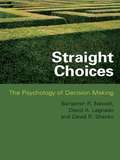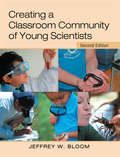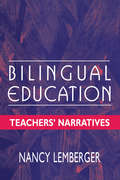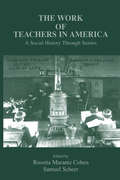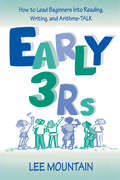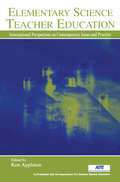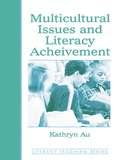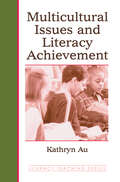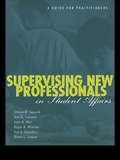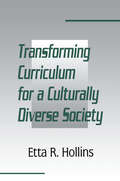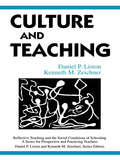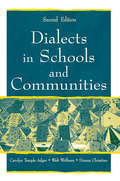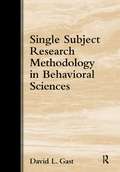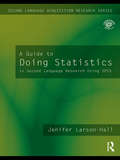- Table View
- List View
Straight Choices: The Psychology of Decision Making
by Ben R. Newell David A. Lagnado David R. ShanksWe all face a perplexing array of decisions every day. Straight Choices provides an integrative account of the psychology of decision making, in which clear connections are made between empirical results and how these results can help us to understand our uncertain world. Throughout the text, there is an emphasis on the relationship between learning and decision making. The authors argue that the best way to understand how and why decisions are made is in the context of the learning and knowledge acquisition that precedes them and the feedback that follows them. The mechanisms of learning and the structure of environments in which decisions are made are carefully examined to explore the ways in which they act on our choices. From this, the authors go on to consider whether we are all constrained to fall prey to biases or whether with sufficient exposure can we find optimal decision strategies and improve our decision making. This novel approach integrates findings from the decision and learning literatures to provide a unique perspective on the psychology of decision making. It will be of interest to researchers and students in cognitive psychology, as well as researchers in economics and philosophy interested in the nature of decision making.
Creating a Classroom Community of Young Scientists
by Jeffrey W. BloomCreating a Classroom Community of Young Scientists helps teachers - both pre-service and in-service - to develop exciting science programs in their classrooms. This book provides the groundwork for designing and implementing a science program that takes into account the latest research in teaching and learning. It provides an approach that will capture children's imaginations, stimulate their curiosity and create a strong foundation for their continued interest in, and appreciation of, science and the world in which they live. The book is designed to be user-friendly, and offers an approach to teaching science that is exciting for teachers as well. This thoroughly revised, second edition focuses on making inquiry more explicit both in terms of the process of inquiry and teaching in ways that capitalize on children's curiosity and questions. New material has also been added on U.S. and Canadian science standards, as well as professional standards for teachers.
Creating a Classroom Community of Young Scientists
by Jeffrey W. BloomCreating a Classroom Community of Young Scientists helps teachers - both pre-service and in-service - to develop exciting science programs in their classrooms. This book provides the groundwork for designing and implementing a science program that takes into account the latest research in teaching and learning. It provides an approach that will capture children's imaginations, stimulate their curiosity and create a strong foundation for their continued interest in, and appreciation of, science and the world in which they live. The book is designed to be user-friendly, and offers an approach to teaching science that is exciting for teachers as well. This thoroughly revised, second edition focuses on making inquiry more explicit both in terms of the process of inquiry and teaching in ways that capitalize on children's curiosity and questions. New material has also been added on U.S. and Canadian science standards, as well as professional standards for teachers.
Bilingual Education: Teachers' Narratives
by Nancy LembergerThis book grew out of the joys and challenges the author experienced as a Spanish/English bilingual teacher of culturally and linguistically diverse students. It tells what it is like to be a bilingual teacher. As a result, it helps other teachers and prospective teachers understand the complex nature of bilingual teaching, shares some successful teaching strategies that other teachers have used, and encourages teachers to find their own solutions despite limited support. The book is structured in three parts. The introduction explains how the book evolved, defines its relation to other qualitative research, and offers suggestions for how to use the book. The second part consists of eight bilingual teachers' stories that provide a glimpse of them as people, their schools and programs, their successes and struggles, and their solutions and coping mechanisms within their contexts. It concludes with a discussion chapter that looks at the teachers' collective strengths and struggles comparatively, connecting these to broader issues. The final section presents bilingual education resources -- useful information for practitioners. This includes foundation texts on the theories and practices of bilingual education, demographic information, a glossary of bilingual education terms, listings of curricula, tests, and literature mentioned by the teachers, and professional network sources.
Bilingual Education: Teachers' Narratives
by Nancy LembergerThis book grew out of the joys and challenges the author experienced as a Spanish/English bilingual teacher of culturally and linguistically diverse students. It tells what it is like to be a bilingual teacher. As a result, it helps other teachers and prospective teachers understand the complex nature of bilingual teaching, shares some successful teaching strategies that other teachers have used, and encourages teachers to find their own solutions despite limited support. The book is structured in three parts. The introduction explains how the book evolved, defines its relation to other qualitative research, and offers suggestions for how to use the book. The second part consists of eight bilingual teachers' stories that provide a glimpse of them as people, their schools and programs, their successes and struggles, and their solutions and coping mechanisms within their contexts. It concludes with a discussion chapter that looks at the teachers' collective strengths and struggles comparatively, connecting these to broader issues. The final section presents bilingual education resources -- useful information for practitioners. This includes foundation texts on the theories and practices of bilingual education, demographic information, a glossary of bilingual education terms, listings of curricula, tests, and literature mentioned by the teachers, and professional network sources.
The Work of Teachers in America: A Social History Through Stories
by Rosetta Marantz Cohen Samuel ScheerThis volume presents a complex portrait of the American teacher through a fascinating range of "story" narratives, including fictional short stories, poetry, diaries, letters, ethnographies, and autobiographies. Through these stories, the volume traces the evolution of the teacher and the profession over the course of two centuries -- from the late 1700s to the late 1900s. In depicting the profession over time, the authors include stories by and about both male and female teachers, as well as teachers from a wide range of cultural and ethnic backgrounds, including white, black, Hispanic, Asian-American, immigrant and native-born, and gay and straight. This book offers accessible, comprehensive introductions to both the central ideas associated with each period and to the representative individual stories that are included within it. The volume editors connect each of the parts to earlier and later ones by tracing evolving themes of feminization, teacher activism, conceptions of curriculum and discipline, and issues of multiculturalism. Questions, suggested readings, and activities are offered at the end of each section. Photographs and drawings -- retrieved from state historical archives -- provide telling images of the teacher in each of the four periods.
The Work of Teachers in America: A Social History Through Stories
by Rosetta Marantz Cohen Samuel ScheerThis volume presents a complex portrait of the American teacher through a fascinating range of "story" narratives, including fictional short stories, poetry, diaries, letters, ethnographies, and autobiographies. Through these stories, the volume traces the evolution of the teacher and the profession over the course of two centuries -- from the late 1700s to the late 1900s. In depicting the profession over time, the authors include stories by and about both male and female teachers, as well as teachers from a wide range of cultural and ethnic backgrounds, including white, black, Hispanic, Asian-American, immigrant and native-born, and gay and straight. This book offers accessible, comprehensive introductions to both the central ideas associated with each period and to the representative individual stories that are included within it. The volume editors connect each of the parts to earlier and later ones by tracing evolving themes of feminization, teacher activism, conceptions of curriculum and discipline, and issues of multiculturalism. Questions, suggested readings, and activities are offered at the end of each section. Photographs and drawings -- retrieved from state historical archives -- provide telling images of the teacher in each of the four periods.
Early 3 Rs: How To Lead Beginners Into Reading, Writing, and Arithme-talk
by Lee MountainThis practical, reader-friendly textbook for preservice and in-service early childhood education and early literacy courses provides "how-to-do-it" instructions for promoting emergent literacy in reading, writing, and arithmetic from preschool into the primary grades. Early 3 Rs answers the question: "What can I SAY and DO to give each child the best possible start on the 3 Rs?" With the strategies and materials in this book, a teacher can give personalized direct instruction in the 3 Rs to a beginner, in just a few minutes a day. The early chapters tell how to prepare a young child for reading, writing, and arithmetic. Subsequent chapters show how to give a beginner an early start on learning the 3 Rs. All strategies begin with the oral approach (from phonemic awareness to "arithme-talk") and then progress to print that is personally meaningful to a young child. Early 3 Rs: * Includes arithmetic as a component of early literacy. * Gives developmentally appropriate methods for direct teaching of the 3 Rs. * Provides scripts of what the teacher can say to promote early learning. * Helps education students in field-based classes offer personalized instruction. Early 3 Rs is written to be very reader friendly: the approach is intentionally eclectic; the writing deliberately avoids heavy theory; the goal is to provide an easy-to-use, highly practical and accessible guide for those who work in early childhood education settings.
Early 3 Rs: How To Lead Beginners Into Reading, Writing, and Arithme-talk
by Lee MountainThis practical, reader-friendly textbook for preservice and in-service early childhood education and early literacy courses provides "how-to-do-it" instructions for promoting emergent literacy in reading, writing, and arithmetic from preschool into the primary grades. Early 3 Rs answers the question: "What can I SAY and DO to give each child the best possible start on the 3 Rs?" With the strategies and materials in this book, a teacher can give personalized direct instruction in the 3 Rs to a beginner, in just a few minutes a day. The early chapters tell how to prepare a young child for reading, writing, and arithmetic. Subsequent chapters show how to give a beginner an early start on learning the 3 Rs. All strategies begin with the oral approach (from phonemic awareness to "arithme-talk") and then progress to print that is personally meaningful to a young child. Early 3 Rs: * Includes arithmetic as a component of early literacy. * Gives developmentally appropriate methods for direct teaching of the 3 Rs. * Provides scripts of what the teacher can say to promote early learning. * Helps education students in field-based classes offer personalized instruction. Early 3 Rs is written to be very reader friendly: the approach is intentionally eclectic; the writing deliberately avoids heavy theory; the goal is to provide an easy-to-use, highly practical and accessible guide for those who work in early childhood education settings.
Elementary Science Teacher Education: International Perspectives on Contemporary Issues and Practice
by Ken AppletonCo-Published with the Association For Science Teacher Education. Reflecting recent policy and standards initiatives, emerging research agendas, and key innovations, this volume provides a contemporary overview of important developments and issues that have that have in recent years shaped elementary science education pre-service courses and professional development, and practices that are shaping future directions in the field. Contributors from several countries who are actively engaged in research and design in elementary science education address:*Conceptual issues which impinge on contemporary science teacher education;*Intersections of content, pedagogy, and practice; and*Professional development as a contextualized practice.Elementary Science Teacher Education: International Perspectives on Contemporary Issues and Practice offers a clear picture of the current state of the field and directions for the future--to the benefit of elementary science teacher educators, aspiring teacher educators, school policy makers, other professionals involved in science education and, ultimately, the millions of elementary school children who will gain from improved practice.
Elementary Science Teacher Education: International Perspectives on Contemporary Issues and Practice
by Ken AppletonCo-Published with the Association For Science Teacher Education. Reflecting recent policy and standards initiatives, emerging research agendas, and key innovations, this volume provides a contemporary overview of important developments and issues that have that have in recent years shaped elementary science education pre-service courses and professional development, and practices that are shaping future directions in the field. Contributors from several countries who are actively engaged in research and design in elementary science education address:*Conceptual issues which impinge on contemporary science teacher education;*Intersections of content, pedagogy, and practice; and*Professional development as a contextualized practice.Elementary Science Teacher Education: International Perspectives on Contemporary Issues and Practice offers a clear picture of the current state of the field and directions for the future--to the benefit of elementary science teacher educators, aspiring teacher educators, school policy makers, other professionals involved in science education and, ultimately, the millions of elementary school children who will gain from improved practice.
Multicultural Issues and Literacy Achievement
by Kathryn AuThis book is a sequel to the author's earlier volume entitled, Literacy Instruction in Multicultural Settings. In addition to extensive updating of earlier material, this book extends the content coverage to include issues of power, attitudes, and systemic change through the application of discourse theory and critical theory. In doing so, however, the author has tried to maintain the brevity, stylistic clarity, and classroom focus of the earlier volume.Key features of this important new book include:*Teaching Flexibility. Although written with the classroom needs of pre-service teachers in mind, theory and research are treated in sufficient depth to make the book suitable for graduate courses and for teacher study groups.*Issues Organization. Each chapter is organized around familiar issues that characterize schools and classrooms with diverse student populations and explores these issues through new lenses that most teachers have not previously encountered.*Social Constructivist Perspective. Critical theory, discourse theory, and historical perspective are introduced in order to sensitize readers to the need to recognize negative, socially sustained patterns that hamper literacy achievement and replace them with positive patterns. To this end each chapter asks students to maintain a running list of negative patterns along with alternative positive patterns.
Multicultural Issues and Literacy Achievement
by Kathryn AuThis book is a sequel to the author's earlier volume entitled, Literacy Instruction in Multicultural Settings. In addition to extensive updating of earlier material, this book extends the content coverage to include issues of power, attitudes, and systemic change through the application of discourse theory and critical theory. In doing so, however, the author has tried to maintain the brevity, stylistic clarity, and classroom focus of the earlier volume.Key features of this important new book include:*Teaching Flexibility. Although written with the classroom needs of pre-service teachers in mind, theory and research are treated in sufficient depth to make the book suitable for graduate courses and for teacher study groups.*Issues Organization. Each chapter is organized around familiar issues that characterize schools and classrooms with diverse student populations and explores these issues through new lenses that most teachers have not previously encountered.*Social Constructivist Perspective. Critical theory, discourse theory, and historical perspective are introduced in order to sensitize readers to the need to recognize negative, socially sustained patterns that hamper literacy achievement and replace them with positive patterns. To this end each chapter asks students to maintain a running list of negative patterns along with alternative positive patterns.
Supervising New Professionals in Student Affairs: A Guide for Practioners
by Steven M. Janosik Don G. Creamer Joan B. Hirt Roger B. Winston Sue A. Saunders Diane L. CooperThis handbook explains the rationale behind supervised practice, and addresses design, supervision, and ethical components that are relevant to both faculty teaching supervised practice courses and supervisors overseeing students on-site.
Supervising New Professionals in Student Affairs: A Guide for Practioners
by Steven M. Janosik Don G. Creamer Joan B. Hirt Roger B. Winston Sue A. Saunders Diane L. CooperThis handbook explains the rationale behind supervised practice, and addresses design, supervision, and ethical components that are relevant to both faculty teaching supervised practice courses and supervisors overseeing students on-site.
Transforming Curriculum for A Culturally Diverse Society
by Etta R. HollinsThe intention of this book is to engage educators in transforming the public school curriculum for a culturally diverse society. This means more than including knowledge about diverse populations. It means reconceptualizing school practices through debate, deliberation, and collaboration involving the diverse voices that comprise the nation. Certain key questions must be addressed in this process: * What should be the purpose of schooling in a culturally diverse society? * Who should be involved in curriculum planning and what process should be employed? * How is the actualized curriculum differentiated? * What is the relationship between school practices and the structure of the larger society? * How should the curriculum be evaluated? The authors of the essays in this book address critical perspectives from which a framework is constructed for a discourse on planning curriculum for a culturally diverse society. In a substantive introduction, Hollins presents the major themes and overall goals of the book and describes how the readings in each of the four parts are linked to each other and to these themes and goals. Each part begins with critical questions and an overview to provide a framework and a focus for the readings that follow, and concludes with suggested learning experiences.
Transforming Curriculum for A Culturally Diverse Society
by Etta R. HollinsThe intention of this book is to engage educators in transforming the public school curriculum for a culturally diverse society. This means more than including knowledge about diverse populations. It means reconceptualizing school practices through debate, deliberation, and collaboration involving the diverse voices that comprise the nation. Certain key questions must be addressed in this process: * What should be the purpose of schooling in a culturally diverse society? * Who should be involved in curriculum planning and what process should be employed? * How is the actualized curriculum differentiated? * What is the relationship between school practices and the structure of the larger society? * How should the curriculum be evaluated? The authors of the essays in this book address critical perspectives from which a framework is constructed for a discourse on planning curriculum for a culturally diverse society. In a substantive introduction, Hollins presents the major themes and overall goals of the book and describes how the readings in each of the four parts are linked to each other and to these themes and goals. Each part begins with critical questions and an overview to provide a framework and a focus for the readings that follow, and concludes with suggested learning experiences.
Culture and Teaching
by Daniel P. Liston Kenneth M. ZeichnerThis is the second volume in the "Reflective Teaching and the Social Conditions of Schooling" series. Reflection in the area of culture and teaching necessarily takes teachers on both an introspective journey and an examination of the social conditions of schooling. There is a need to know not only what they believe but also what schools do. It has long been charged that our educational system privileges some and disenfranchises others. Schools are not the equitable institutions that one would hope them to be--a feature of schooling and one that deserves a great deal more attention. This work facilitates an examination of its readers' own beliefs, acquaints them with the sentiments and arguments of others, and encourages them to look further into the social conditions of schooling.
Culture and Teaching
by Daniel P. Liston Kenneth M. ZeichnerThis is the second volume in the "Reflective Teaching and the Social Conditions of Schooling" series. Reflection in the area of culture and teaching necessarily takes teachers on both an introspective journey and an examination of the social conditions of schooling. There is a need to know not only what they believe but also what schools do. It has long been charged that our educational system privileges some and disenfranchises others. Schools are not the equitable institutions that one would hope them to be--a feature of schooling and one that deserves a great deal more attention. This work facilitates an examination of its readers' own beliefs, acquaints them with the sentiments and arguments of others, and encourages them to look further into the social conditions of schooling.
Dialects in Schools and Communities
by Carolyn Temple Adger Walt Wolfram Donna ChristianThis book describes dialect differences in American English and their impact on education and everyday life. It explores some of the major issues that confront educational practitioners and suggests what practitioners can do to recognize students’ language abilities, support their language development, and expand their knowledge about dialects. Topics addressed include:*popular concerns about the nature of language variation;*characteristic structures of different dialects;*various interactive patterns characteristic of social groups;*the school impacts of dialect differences in speaking, writing, and reading, including questions about teaching Standard English; and*the value of dialect education in schools to enable students to understand dialects as natural and normal language phenomena. Changes in the Second Edition: In this edition the authors reconsider and expand their discussion of many of the issues addressed in the first edition and in other of their earlier works, taking into account especially the research on dialects and publications for audiences beyond linguistics that have appeared since the first edition. This edition is offered as an updated report on the state of language variation and education in the United States. Dialects in Schools and Communities is rooted in questions that have arisen in workshops, surveys, classes, discussion groups, and conversations with practitioners and teacher educators. It is thus intended to address important needs in a range of educational and related service fields. As an overview of current empirical research, it synthesizes current understandings and provides key references—in this sense it is a kind of translation and interpretation in which the authors’ goal is to bring together the practical concerns of educators and the vantage point of sociolinguistics. No background in linguistics or sociolinguistics is assumed on the part of the reader. This volume is intended for teacher interns and practicing teachers in elementary and secondary schools; early childhood specialists; specialists in reading and writing; speech/language pathologists; special education teachers; and students in various language specialties.
Dialects in Schools and Communities
by Carolyn Temple Adger Walt Wolfram Donna ChristianThis book describes dialect differences in American English and their impact on education and everyday life. It explores some of the major issues that confront educational practitioners and suggests what practitioners can do to recognize students’ language abilities, support their language development, and expand their knowledge about dialects. Topics addressed include:*popular concerns about the nature of language variation;*characteristic structures of different dialects;*various interactive patterns characteristic of social groups;*the school impacts of dialect differences in speaking, writing, and reading, including questions about teaching Standard English; and*the value of dialect education in schools to enable students to understand dialects as natural and normal language phenomena. Changes in the Second Edition: In this edition the authors reconsider and expand their discussion of many of the issues addressed in the first edition and in other of their earlier works, taking into account especially the research on dialects and publications for audiences beyond linguistics that have appeared since the first edition. This edition is offered as an updated report on the state of language variation and education in the United States. Dialects in Schools and Communities is rooted in questions that have arisen in workshops, surveys, classes, discussion groups, and conversations with practitioners and teacher educators. It is thus intended to address important needs in a range of educational and related service fields. As an overview of current empirical research, it synthesizes current understandings and provides key references—in this sense it is a kind of translation and interpretation in which the authors’ goal is to bring together the practical concerns of educators and the vantage point of sociolinguistics. No background in linguistics or sociolinguistics is assumed on the part of the reader. This volume is intended for teacher interns and practicing teachers in elementary and secondary schools; early childhood specialists; specialists in reading and writing; speech/language pathologists; special education teachers; and students in various language specialties.
Single Subject Research Methodology in Behavioral Sciences
by Jennifer R. Ledford David L. GastThis book is written for student researchers, practitioners, and university faculty who are interested in answering applied research questions and objectively evaluating educational and clinical practices. The basic tenet of single-subject research methodology is that the individual is of primary importance and that each individual study participant serves as his or her own control. It is because of this focus on the individual that clinicians and educators have been using single-subject research designs for over 40 years to answer applied research questions. Although the methodology has its roots in behavioral psychology and applied behavioral analysis, it has been used by applied researchers across a variety of disciplines such as special education, speech and communication sciences, language and literacy, therapeutic recreation, occupational therapy, and social work. Key features include the following: Applied Focus – More than any other text, this one focuses on the nuts and bolts of how to use single-subject research in constructing one’s research project or in evaluating one’s professional practice. Numerous and Varied Examples – The book abounds in examples from special education and other disciplines and populations within the applied research literature. Reader Friendly – The text is written in a reader friendly style, features sample data sheets and graphic displays, and includes detailed guidelines for conducting visual analysis of graphic data. Expertise – The author’s long and distinguished career in teaching single-subject research is augmented in this book by contributions from other experts in the field.
Single Subject Research Methodology in Behavioral Sciences
by Jennifer R. Ledford David L. GastThis book is written for student researchers, practitioners, and university faculty who are interested in answering applied research questions and objectively evaluating educational and clinical practices. The basic tenet of single-subject research methodology is that the individual is of primary importance and that each individual study participant serves as his or her own control. It is because of this focus on the individual that clinicians and educators have been using single-subject research designs for over 40 years to answer applied research questions. Although the methodology has its roots in behavioral psychology and applied behavioral analysis, it has been used by applied researchers across a variety of disciplines such as special education, speech and communication sciences, language and literacy, therapeutic recreation, occupational therapy, and social work. Key features include the following: Applied Focus – More than any other text, this one focuses on the nuts and bolts of how to use single-subject research in constructing one’s research project or in evaluating one’s professional practice. Numerous and Varied Examples – The book abounds in examples from special education and other disciplines and populations within the applied research literature. Reader Friendly – The text is written in a reader friendly style, features sample data sheets and graphic displays, and includes detailed guidelines for conducting visual analysis of graphic data. Expertise – The author’s long and distinguished career in teaching single-subject research is augmented in this book by contributions from other experts in the field.
A Guide to Doing Statistics in Second Language Research Using SPSS
by Jenifer Larson-HallThis valuable book shows second language researchers how to use the statistical program SPSS to conduct statistical tests frequently done in SLA research. Using data sets from real SLA studies, A Guide to Doing Statistics in Second Language Research Using SPSS shows newcomers to both statistics and SPSS how to generate descriptive statistics, how to choose a statistical test, and how to conduct and interpret a variety of basic statistical tests. It covers the statistical tests that are most commonly used in second language research, including chi-square, t-tests, correlation, multiple regression, ANOVA and non-parametric analogs to these tests. The text is abundantly illustrated with graphs and tables depicting actual data sets, and exercises throughout the book help readers understand concepts (such as the difference between independent and dependent variables) and work out statistical analyses. Answers to all exercises are provided on the book’s companion website, along with sample data sets and other supplementary material.
A Guide to Doing Statistics in Second Language Research Using SPSS
by Jenifer Larson-HallThis valuable book shows second language researchers how to use the statistical program SPSS to conduct statistical tests frequently done in SLA research. Using data sets from real SLA studies, A Guide to Doing Statistics in Second Language Research Using SPSS shows newcomers to both statistics and SPSS how to generate descriptive statistics, how to choose a statistical test, and how to conduct and interpret a variety of basic statistical tests. It covers the statistical tests that are most commonly used in second language research, including chi-square, t-tests, correlation, multiple regression, ANOVA and non-parametric analogs to these tests. The text is abundantly illustrated with graphs and tables depicting actual data sets, and exercises throughout the book help readers understand concepts (such as the difference between independent and dependent variables) and work out statistical analyses. Answers to all exercises are provided on the book’s companion website, along with sample data sets and other supplementary material.
